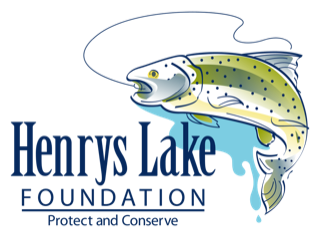
This year the foundation funded over $35,000 for fish passage improvement projects at Henrys Lake. This constitutes the largest single year financial commitment in the foundation’s history. Committed projects for 2011 include the installation of two new modular diversion screens on Targhee Creek and three new modular diversion screens on Duck Creek. All of these screens were designed and manufactured at the IDFG screen shop in Salmon Idaho and incorporate improved engineering for more effective maintenance free screening and fish passage.
In order to maximize natural reproduction of the Yellowstone Cutthroat trout it is essential that all irrigation diversions on the key tributaries of Henrys Lake be screened, ensuring that spawning adfluvial fish and fry don’t end up in an irrigated field. The first of the two screens for Targhee Creek was installed on the Salisbury property August 22 under the direction of Jim Hardy from the IDFG. The second and largest of the Targhee screens is planned for installation upstream on the Stockon property. With an HLF commitment of $17,500, it is the largest and most complex screen funded by the Foundation to date. With these new screens, all of the diversions on Targhee Creek, the major tributary to Henrys Lake, will be screened.
The first of the three Duck Creek screens planned for the Parkinson property was installed on August 23. The final two will be installed this fall. This will complete the screening of all diversions on this important tributary from Red Rock Road to the lake. The final HLF sponsored project for 2011 will be the removal of the double barrel culvert on Duck Creek on the Pearson property commensurate with the rerouting of Red Rock Road. This will return this section of Duck Creek to its natural pathway. This will be the last of the four culverts replaced or removed at Red Rock Road over the past two years.
Led by Lee Mabey of the U.S. Forest Service, this work on Red Rock road will eventually provide unobstructed passage for spawning fish to six miles of Duck Creek and its tributaries. As stated by Phil Barker, President of the Henrys Lake Foundation, “The foundation is extremely appreciative of the past support of its members and the community and takes great pride in its stewardship of the Henrys Lake fishery and positive results of its past efforts. It is only with the contributions and active involvement of our members, partners and community that the foundation can be successful. In that regard the foundation is continually seeking input of possible future projects that may provide benefit to the fishery and protection of Henrys Lake and the Yellowstone Cutthroat trout. If you are interested in joining the foundation, contributing as a volunteer or are aware of any opportunities that would enhance the natural reproduction of the Yellowstone Cutthroat trout, advance the Henrys Lake fishery, improve riparian habitat or otherwise protect the unique environment of Henrys Lake please contact the foundation at web@henryslakefoundation.com with your ideas.”
